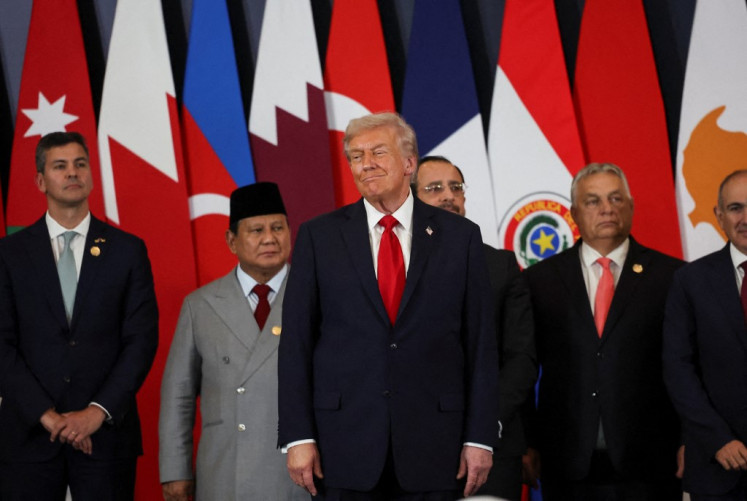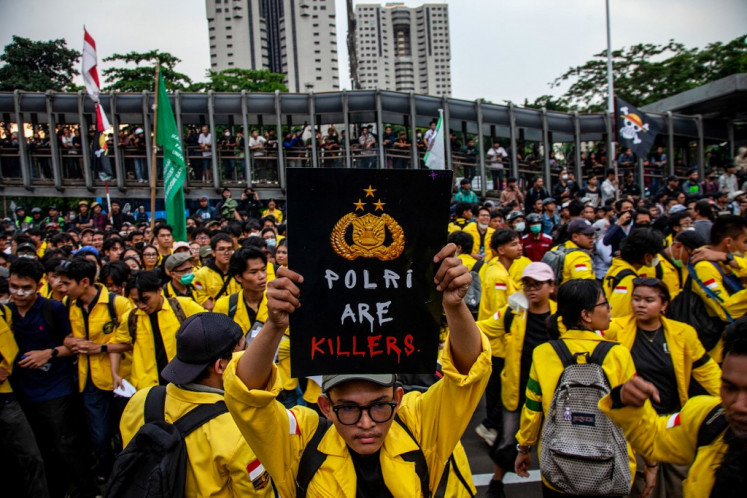Popular Reads
Top Results
Can't find what you're looking for?
View all search resultsPopular Reads
Top Results
Can't find what you're looking for?
View all search resultsWorld Health Day: A brief history of the BPJS Kesehatan
The Health Care and Social Security Agency (BPJS Kesehatan) is the administrator for Indonesia’s national health insurance (JKN) health coverage program
Change text size
Gift Premium Articles
to Anyone
T
he Health Care and Social Security Agency (BPJS Kesehatan) is the administrator for Indonesia’s national health insurance (JKN) health coverage program. With 195.2 million participants (as of April 1), it is one of the biggest programs of its kind in the world.
What makes the BPJS Kesehatan unique among insurance programs is that it emphasizes a cross-subsidy system, where the rich help pay for the poor. In other insurance programs, it is every man for himself.
Another difference is philosophical, as the BPJS aims at preventive health care rather than curative. Each member is assigned to a primary healthcare facility, which can be a community health center (Puskesmas) or family doctor. These facilities are expected to promote a healthy lifestyle to prevent sickness in the first place.
Though the BPJS Kesehatan officially began its operations in 2014, its history, however, stretches as far back as 1949, when the government of the newly independent Indonesia expressed goals of providing guaranteed healthcare coverage for its people.
National health insurance
It was not until 1968 that the government released a formal policy that regulated healthcare coverage. At the time, however, the system only provided coverage to its civil servants and pensioners, alongside their family members.
An important figure for healthcare insurance at the time was then-health minister G.A. Siwabessy, who believed that the country needed to establish a universal health insurance program the way other developed and developing countries were doing.
In charge of handling this insurance system was the Agency for Healthcare Fund Maintenance (BPDPK), which was part of the Health Ministry.
At first, the agency suffered from serious funding issues. Back then, the agency worked on a “fee for service reimbursement” system that saw it replacing all healthcare costs based on the number of services the participants were using.
The government solved this finance issue in the 1980s by introducing a payment policy that made use of a capitation system, an all-in referral process, and limited individual claims.
Expanded coverage
It was also in the late 1980s that the government began expanding its coverage to encompass more than just the above-mentioned civil servant-related demographics.
It was then that the government issued Government Regulation No. 22 and No. 23 in 1984 that transformed the BPDPK from a part of the Health Ministry to a state-owned enterprise (SOE), the Husada Bakti Public Company (PHB).
The system now extended coverage to civil servants, retired civil servants, retired military personnel and their family members. Other changes included the removal of the policy of individual claims and the change of the fee-for-service system into a managed care system.
It was not long before the PHB underwent another evolution. In 1992, Husada Bakti’s status was changed to a limited liability company and was renamed PT Askes, as part of Government Regulation No. 6 of that year.
With this change also came an expansion of coverage. From very early on, Askes began reaching out to more Indonesians, including employees of SOEs. By 1993, Askes had also begun working together with nearly 150 non-government hospitals.
As it expanded its coverage, the quality of its services improved. In fact, by 2001, Askes’ services had become so high in quality that an audit gave the company an unqualified “very healthy” rating.
In the 2000s, Askes’ healthcare coverage had expanded to include tens of millions of poor and underprivileged people in the country unable to afford their own insurance. By the mid-2000s, more than 6 million people in 200 regencies and municipalities had become participants in Askes’ Regional Public Healthcare Insurance program.
One province in particular, Aceh, had entrusted Askes with managing the province’s Aceh Healthcare Insurance program. Other provinces, such as North Sulawesi, West Sumatra, Jambi and East Nusa Tenggara, followed suit.
The healthcare momentum around this time was also helped by the government releasing its laws on the National Social Security System (SJSN) in 2004 and later on in 2011 with its Social Security Providers (BJPS) Law.
Birth of BPJS
The new BPJS Law created two social security agencies: the BPJS Kesehatan, which would begin operations in 2014, and the BPJS Ketenagakerjaan, which would begin operations in July 2015.
The BPJS Kesehatan was given responsibility for managing universal social health insurance, while BPJS Employment would be responsible for managing the programs on pension, old age, death and work accident benefits.
In 2014, the BPJS Kesehatan was born from the transformation of Askes. In addition to the above-mentioned BPJS Law from 2004, the BPJS Kesehatan also makes reference to Law No. 40/2004 on the national social security system in its provision of JKN, a fee-based compulsory social health insurance, the objective of which is to achieve health insurance coverage for all Indonesians.
The BPJS Kesehatan also shares the spirit of Nawa Cita (nine-point development program) championed by President Joko “Jokowi” Widodo in revitalizing the role of the state in protecting all people and providing security to all citizens.
With its brief history, the organization has suffered a number of financial deficits, including Rp 9.7 trillion in 2016 and Rp 9 trillion in 2017, caused mainly by trouble with collecting premium payments.

















